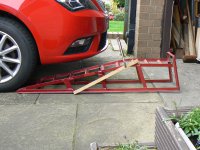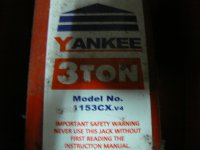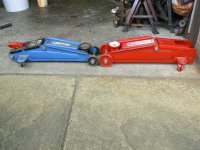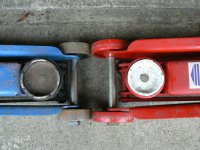The parts list is what a mechanic friend suggested. I've bought it incredibly cheap, so spending a few hundred to fix it up will be absolutely worth it.
Concerning that kit, I never noticed it didn't have the adjuster, so perhaps that's something extra I'll need.
I'm with Koalar on this. Like him I'd only buy the parts needed. As he says, the adjusters are known to fail but then again I've never needed one. Springs are quite easy to asses but double check the little hold down springs, that's the ones that hold the shoes against the backplate, are strong enough to properly hold the shoes back against the backplate. If they are weak it allows the shoes to pull slightly away from the backplates which can end up with the shoes rubbing on the drum when driving.
If I'm doing a service I can predict I'm going to need oil and an oil filter, Air filter maybe, cabin filter maybe, spark plugs maybe, etc. I don't know 'till I've stripped it down whether I'll need pads, shoes, fitting kit, maybe even a caliper or wheel cylinders. In other words I like to asses what I've got before ordering parts and then order only what's needed. This works well for me as I've got SRS within a 10 minute drive, or even, if necessary, I can walk it in a half hour max.
Thinking about comments earlier in the thread where koalar was talking about axle stands and trolley jacks. One of the first things I ever bought was a pair of ramps. Back in the '60's these worked well on my Anglia, Minis and Cortina but I soon discovered that they are all very well if you're doing something like an oil change but useless if you need to take a wheel off to look at the brakes. Then more modern front wheel drive vehicles became the norm and front overhang increased considerably. Look at how much there is on my neighbour's Polo:

Most ramps won't start to lift the car before the front grounds on the ramp. This was what I found with mine so I cut the weld on the end and extended using some angle iron. Here is one against the front of the Ibiza. The bit of wood shows what it was like before extending:

Unlike koalar, I like working with my axle stands:

The ones nearest the camera are the ones I bought back in the late 60's when I was in college. The only problem they gave me was that, on hot London summer days, with the weight of the car on them, they would sink into the tarmac! As bought they didn't have those flat pads on the bottom of the legs. I took them into the college and the instructor made a wee project out of them for me getting me to make the pads, cut the ends of the legs so they were perfectly parallel to the ground and then weld them on. He even listed it on my worksheets and marked me on the project! As you can see they are perfectly formed and beautifully welded! I also like this pair because they have a nice flat saddle which supports a wooden block nicely. The next pair along I bought some time later so i could get the whole car up off the ground and you'll notice the foot pads are not so exactingly made! The yellow pair were given to me by a light commercial vehicle mechanic friend who was retiring and vowed he'd never touch a vehicle again! with a slabbed driveway run off, I don't really have to worry about soft tarmac these days.
If you are going to do any more than the occasional fiddle about with cars then a trolley jack is a great asset to have. Doesn't need to be a "professional" grade bit of kit but I'd advise against something aimed at the "DIYer" You can buy a very cheap one for maybe around £25 - they appear from time to time in some of the discount supermarkets. They do actually work too, how they make them for that price I don't know. The problem I have with them though is that they don't actually have much range of lift. If they have a nice low saddle height (and some cars are pretty low to the road now a days for aerodynamic reasons) then they don't have the lift to get the car up on stands. Others get decent lift by having a high resting saddle height which makes them impossible to get under lower cars.
I bought this one - Branded Hilka - about 40 years ago I think, a long time ago anyway:
I notice Halfords were selling it - painted yellow and black - up until a year or so ago, branded Halfords of course. It has a max saddle height of 415mm (approx 16.25 inches in "real money") and a resting saddle height of 120mm (4.5 inches) It's paired well with my favourite axle stands which are 400mm on their second hole. - as you can see here.
The jack is, unsurprisingly, made in the far east and I've not seen this actual model currently on sale anywhere. However the Sealey 1153CX is a dead ringer for it:



The saddle is slightly smaller in diameter and the wheels just a little bigger. I turned this one up on Gumtree with an address just up the road from me. The Hilka was leaking slightly with a badly worn pumping element. The price was right so I bought it - I was surprised to find it had hardly been used but the chap told me it was just too much of a nightmare now his street had been yellow lined. After a wee while I realized the pumping body was the exact same as that in the Hilka so I just swapped it into the Hilka chassis as I liked my old "friend" better.
Nowadays small good quality jacks like these are almost as expensive as a more professional jobbie so I think I'd just buy a larger one and be done with it.
Trolley Jack 3 Tonne Long Reach Heavy-Duty. Capacity: 3 Tonne. • VERSATILE LIFTING RANGE - Minimum saddle height 140mm, maximum saddle height 432mm. • LONG REACH - 625mm Long chassis length to negotiate deeper jacking points.
www.ebay.co.uk
Or maybe:
https://www.machinemart.co.uk/p/clarke-ctj2000lpb-2-tonne-low-profile-trolley-/ but it doesn't have quitethe height of lift.
As against something like this offer:
Designed for serious car enthusiasts and hobbyists, this is a 3 ton heavy duty trolley jack perfect for home garages and workshops. The TJ3X will lift a larger vehicle, such as a fully loaded van or 4x4 with a gross vehicle capacity of 3.5 tonne.

www.sgs-engineering.com
Hopefully I don't need to repeat the age old advice to never, never ever, get under, or even put a pinky finger under, a vehicle supported only on a jack - any sort of jack.







